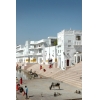|
 Once the Indian state of Rajasthan was consisted of twenty two separate principalities. On arrival here, one gets an impression of being back in the past: in the times, when luxury and splendor attested to rulers' authority. Nowadays maharajas' palaces accomodate luxurious hotels. Once the Indian state of Rajasthan was consisted of twenty two separate principalities. On arrival here, one gets an impression of being back in the past: in the times, when luxury and splendor attested to rulers' authority. Nowadays maharajas' palaces accomodate luxurious hotels.
The formidable fortress of Jodhpur dominates the landscape, and it
looks like a perfect scenary for a historic picture. The steep road
runs upward to the gate. High walls and other city fortifications were
built in the XV century. This is just one of many fortresses in the
Indian state, of the size of Ukraine. Behind the walls a traveller gets
overwhelmed with the Eastern magic. Here he witnesses the splendor of
Indian rulers of the Middle Ages. Lattices made of filigree processed
sandstone, wall paintings and colored glass decorate enormous
accomodations inside the fortress. The marble throne with gold
finishing, assigned for Jodhpur rulers' coronation ceremonies, is on
display. In another room there is a palanquin made of pure gold, so
heavy, that it takes a dozen of men to carry it. Armory Chamber is
filled up with testimonies about the glorious past of fort Meherangarh,
which means "Majestic". Twenty two former principalities of Rajasthan
were of different origin, and they were constantly at war with one
another for power and influence. Only after India obtained independence
from Great Britain in 1947, the principalities were united into one
state. However, until 1974 local lords, maharajas, preserved
significant privileges. In 1974 they were ripped of their special
status and became ordinary citizens.
Some maharajas converted
their palaces into luxury hotels. Thus, for instance, the hotel Umaid
Bhawan Palace appeared in Jodhpur. It was built about 60 years ago as a
symmetrical structure with a 190 feet dome. This is one of the largest
private dwellings in the world. Rooms are designed in the style of
art-decor which combines luxury and austerity, ethnic motives and
modern materials, such as ivory, crocodile skin, rare tree species,
silver or aluminum. Staff wear bright colorful clothing. This hotel has
got everything - no wishes left unfulfilled. A glass of Sundowner
cocktail (vodka, orange, lemon and cranberry juices, and pomegranate
syrup), brings refreshment in the dry Indian climate. Deep dark-blue
color of indigo is a color of choice in Jodhpur.
Unlike
Jodhpur, the capital of Rajasthan Jaipur is popularly known as a "pink
city". Buildings here, including the famous "Palace of Winds", are made
of pink stucco in imitation of sandstone, or just painted pink by the
poor. Tthey continue to do this nowadays. The fortress has the
maharaja's palace with a stone observatory on its territory. Tourists
do not stay here long: they are in a hurry to see the ancient capital
Amber, famous for its palace and fortress. From Jaipur the road goes
through the mountains, and in half an hour travellers gaze at
800-year-old Amber in the gray-blue skies. Tourists are taken there by
elephants. Formidable walls hide the luster stage of court life of
rajputs (members of Indian military cast). Splendid chambers are
decorated with mosaics, frescoes, precious stones and pearls.
While
tourist centers of Rajasthan have visible signs of modernization, many
old capitals of Indian feudal lords reject changes at all, like fort
Jaisalmer in the Western part of the state which was on guard against
raids of robbers, "wild wolves of desert", coming from the Thar desert.
Once the most important shopping center of Bikaner lonely sits in the
Thar desert. To reach it, one has to ride a camel, as travelers used to
do long ago. The huge fortress of Bikaner was built in the XVI century,
and there are over 30 palaces and temples within its walls.
Approximately 210 miles of desert lies between Jaisalmer and Bikaner.
For those, who want to see India with their own eyes, bus tours are
available though it is better to hire a car with a driver. Indian
streets are very busy and full of weird means of transportation. One
can see sacred cows, wondering around, elephants in no hurry, camels
slowly pulling loaded carts, and pedestrians ignoring automobiles.
Thus, it is safer to let somebody else drive. Anyway, you will not be
able to make even to 40 mph, average speed is about 30 mph. Railroad is
considerably faster. The trip shorter than two weeks is not worth
planning: you will not see much. Winter is the best time for a visit to
Rajasthan as local guides advise. At night temperatures may be lower
than 30 F, but in the daytime it is very pleasant. In summer
temperatures rise up to 120 F: it is possible to just melt down. In
order to see places one has to stay on the move.
|